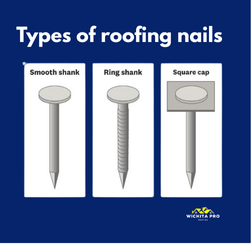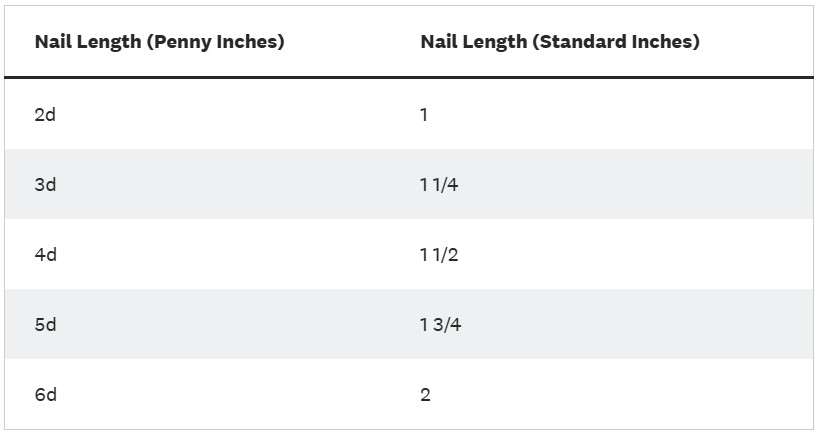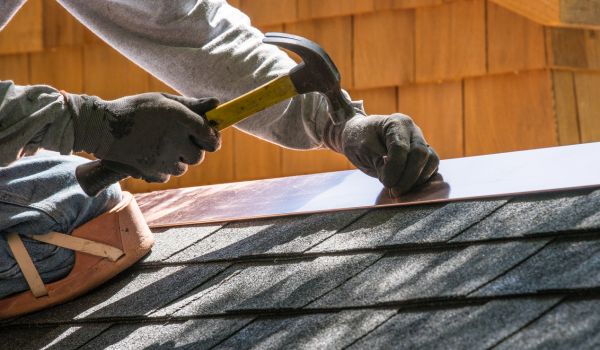
Everything you need to know about roofing nails
While nails might appear to be a minor component of your roof, they actually play a crucial role in holding everything together. For roofing nails to remain firmly in place and provide your home with a fully functional, protective covering, they must be appropriately sized.
Choosing the correct type of roofing nails involves considering the thickness of your roof?s other materials?like the decking and shingles. Below is an overview of how these components impact nail selection, what happens when your roof has nails of the wrong size, and the steps you can take to address it.
Types of Roofing Nails
There are three main types of roofing nails you?ll come across. Each one serves a specific purpose, and the best choice depends on your roofing material, overall budget, and which part of the roof you?re securing.

3 roofing nail types compared visually, including smooth shank and square cap
Smooth Shank
When you imagine a standard nail, you?re probably envisioning a smooth shank. These nails have a completely smooth shaft?the part you drive into the roofing material. They?re the most basic and budget-friendly type, yet still strong enough for many applications.
Ring Shank
Ring shank nails resemble smooth shank nails, but the shaft includes screw-like ridges. While you don?t actually twist them into the roof, these grooves significantly enhance grip and help keep everything more securely in place.
Square Cap
You won?t typically see this type of nail on asphalt shingles. Instead, it?s used for securing underlayment. You can identify a square cap nail by its coiled or smooth shaft topped off with a wide, square-shaped head.
Most Common Roofing Nail Materials
Roofing nails can be made from various metals. Some last longer than others, so it?s important to consider the intended lifespan of your roof. Your local climate also matters. If you live near the coast, salt air and moisture can corrode nails more quickly.
Galvanized Steel
Galvanized steel is one of the most common materials for roofing nails. It?s resistant to rust and corrosion, though not to the same degree as stainless steel. The trade-off is cost: galvanized steel nails are more affordable and typically work well in areas without intense precipitation. There are two kinds:
- Hot-dipped galvanized nails: dipped in a zinc solution for added durability.
- Electro-galvanized nails: made with a thinner zinc coating through an electric and chemical process.
Stainless Steel
Stainless steel nails come with a higher price tag, which is why they?re generally used in places where corrosion is a bigger concern?like coastal areas with salt spray or regions with heavy rainfall.
Copper
Copper nails also cost more, but they?re among the most durable options available. This is a popular choice for roofs with a very long lifespan, such as clay or tile roofs. They?re also used when installing copper flashing.
Aluminum
Aluminum nails are less frequently used than other varieties. They?re not suited for coastal environments (where they could be exposed to salt) or industrial areas (where they might be exposed to harsh chemicals). However, roofers sometimes employ aluminum nails for certain metal roofing and shingle installations.
Roofing Nail Sizes
Roofing nails are typically measured by gauge (diameter) and length. They?re usually between 1 and 2 inches long, with a gauge range of about 10 to 12. This is different from the nails you?d use for securing roof trusses, which tend to be 3 to 3 1/2 inches long.
Nail gauge indicates how thick the nail is, and the bigger the gauge number, the thinner the nail. In other words, the smaller the gauge, the stronger the nail. Generally, a roofing nail should be at least 12 gauge.
Some nails are labeled with the letter ?d,? indicating penny length?an older sizing system. The table below helps convert penny length measurements:

Can Roofing Nails Be Too Long or Too Short?
While a roofing nail must be long enough to penetrate the roof deck, it is possible to go overboard. A nail measuring 3 inches (or more) could penetrate through the decking and into the attic ceiling. Overly long nails might cause leaks or create a safety hazard for anyone working in the attic.
A nail that?s too short can be just as problematic. Without adequate penetration, strong winds may lift and damage your roof. The roofing materials could loosen in an updraft and become a safety risk.
How Many Roofing Nails Do You Need per Square?
Roofer worker using air or pneumatic nail
The number of roofing nails required per square depends on both the type of roofing material and the section of the roof in question. For instance, large shingles need fewer nails because they cover more surface area. When installing roof decking or sheathing, add nails anywhere the decking meets a truss, spacing nails roughly 8 inches apart.
The nail count for each shingle can vary by manufacturer. Most recommend using four to six nails per shingle, with more on the first row than the rest of the roof. Local building codes also come into play. In total, most homeowners end up needing about 350 roofing nails per square.
Read more: How to Choose the Best Roofing Material for Wichita's Climate
How to Choose the Right Type of Roofing
Nails Selecting the best roofing nails for your project requires considering several factors?from the thickness of your roof materials to the specific layer of your roof.
If you?re not sure where to begin, consult the manufacturer?s instructions or local building codes. Otherwise, the steps below can help guide you.
1. Consider the Type of Roof
The kind of roof you have is a major deciding factor when it comes to choosing the right roofing nails. Depending on the materials, you may need different nails for shingles, sheathing, and flashing. Sometimes, the same nails work for the entire job. Keep the following points in mind:
Asphalt
If you?re fastening asphalt shingles to sheathing, the thickness of the sheathing determines nail length. Thicker sheathing calls for longer nails (though 1 to 1 1/4 inches is most common).
Wood Shakes
Wood shakes present unique challenges. They absorb moisture, so it?s wise to use corrosion-resistant nails if you live in an area with abundant rain or snow. Wood shakes are also generally thicker than standard shingles and don?t always have uniform thickness. Most manufacturers recommend nails between 1 1/4 inches and 2 inches in length.
Decking (Sheathing)
When attaching sheathing to roof trusses, secure hold is crucial. Many roofers prefer ring shank nails, and you might need a longer nail than expected?particularly if your decking is thicker than 1/2 inch.
Felt or Underlayment
For felt or underlayment, square cap nails (with either plastic or metal caps) are commonly used. Metal roofing manufacturers often advise using plastic caps, and 1 inch is a standard length. Staples are also allowed by most building codes as an alternative.
Flashing
You can often use the same nails for flashing that you use for shingles. However, if you?re installing copper flashing, you?ll likely need copper nails.
2. Consider the Nail Size
Selecting the correct nail length is vital for a secure, long-lasting roof. Roof nails typically have a 3/8-inch diameter head to keep materials firmly in place. If the head is too large, though, it might be tough to conceal, potentially leading to issues later on.
From sheathing to shingles, you?ll usually need nails ranging from 1 inch to more than 2 inches.
Decking
The thickest modern decking usually measures just under an inch, with most decking at around 3/4 inch in thickness. In these cases, roofing nails are typically around 19 mm long and should penetrate at least 3/4 inch into the deck.
Shingles
For thicker shingles, contractors often opt for 30 mm nails. If they?re installing a second layer of shingles, they might use nails of at least 35 mm. The nail size also depends on the type of shingle?fiberglass and asphalt typically require 1-inch nails, whereas wooden shingles may need something longer.
Additional Layers If your roof includes extra layers (such as an overlay), your nails should be long enough to pass completely through all the roofing material and into the deck or sheathing. This can mean using nails that are 2 inches long or more.
3. Choose the Right Nail Material
It?s easy to overlook the importance of nail material, but it can have a substantial impact. For instance, certain metal roofing manufacturers specify nails with plastic caps rather than metal caps for underlayment.
Galvanized steel is common, but if you live in a region with frequent rain or salty air, stainless steel nails might be worth the investment.
4. Consider the Long-Term
Cost A roof replacement typically falls between $5,900 and $12,900. You don?t want to risk premature repairs or replacements due to the wrong choice of roofing nails. An option that?s slightly more expensive now can help you avoid bigger costs down the road. When in doubt, consult a local roofing professional for guidance on which roofing nails are best for your home.
--
Frequently asked questions about Roofing Nails
Why are roofing nails so important?
Roofing nails may seem small, but they?re essential because they hold together the various layers of your roof. Properly sized and installed nails help maintain a stable, protective covering that can withstand harsh weather conditions and everyday wear.
What types of roofing nails are commonly used?
Three primary types of roofing nails include smooth shank, ring shank, and square cap. Smooth shank nails are the most basic and affordable, ring shank nails have screw-like ridges for extra grip, and square cap nails (typically for underlayment) feature a larger, square-shaped head.
Which nail materials are best for coastal or wet climates?
Stainless steel and copper nails are more resistant to rust and corrosion, making them excellent choices for coastal areas or locations with high precipitation. Galvanized steel is also popular, though it?s slightly less corrosion-resistant than stainless steel.
How do I determine the right size roofing nail?
Roofing nail size depends on the thickness of the decking and shingles. In general, nails range from 1 to 2 inches in length and are often between 10 and 12 gauge. The nail must penetrate the roof deck adequately?typically at least 3/4 of an inch?without being so long that it protrudes into the attic space.
What happens if I use nails that are too short or too long?
Too short: The nail won?t penetrate far enough into the roof decking, making shingles more likely to lift or blow off during high winds.
Too long: The nail could puncture through the decking, creating the potential for leaks or posing a safety hazard inside the attic.
How many roofing nails do I need per square of shingles?
Most manufacturers recommend four to six nails per shingle, though the specific number can vary based on shingle size and local building codes. On average, homeowners use around 350 nails per square.
Can I use the same roofing nails for flashing?
Yes, in most cases, you can use the same nails for flashing that you use for shingles. However, if you?re working with copper flashing, it?s best to use copper nails to ensure consistent corrosion resistance and a secure installation.
Should I consider the long-term cost when choosing roofing nails?
Absolutely. While certain materials (like stainless steel or copper) might cost more upfront, they can help prevent premature roof repairs or replacements. Investing in high-quality roofing nails can save money over the lifespan of your roof.
What if I?m unsure about local building codes or specific nail requirements?
Always check the manufacturer?s installation guidelines and consult local building codes to ensure you?re using the correct type, size, and material of roofing nails. When in doubt, contact a professional roofer for expert advice.
